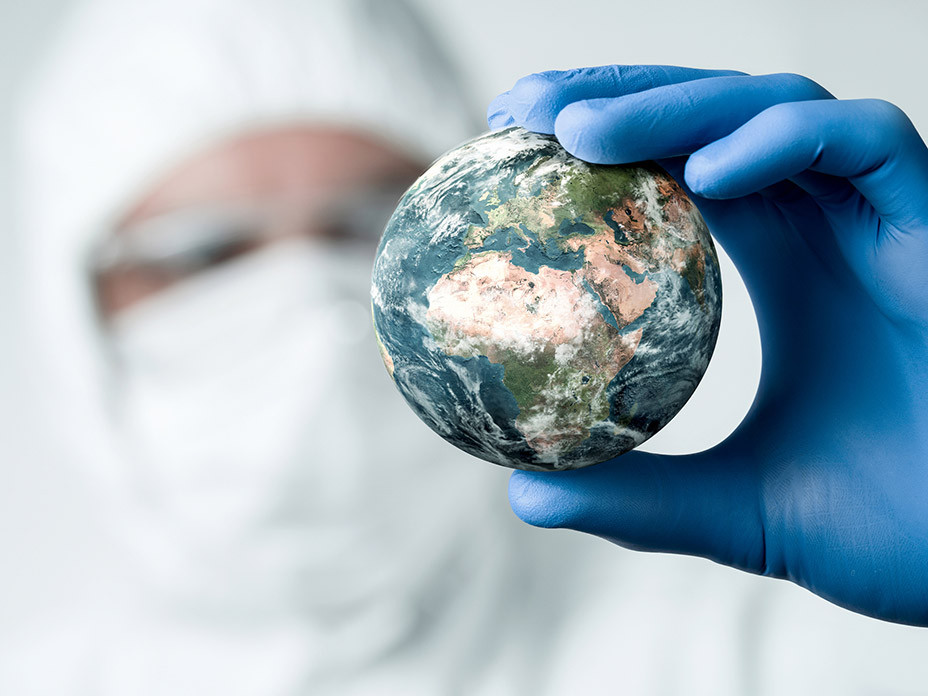 Global Press reporter Sunita Neupane takes photos during a photojournalism training in Nepal in March 2020. (Photo by Mareike Guensche)
Global Press reporter Sunita Neupane takes photos during a photojournalism training in Nepal in March 2020. (Photo by Mareike Guensche)
Countless global organizations—whether nonprofits coordinating volunteers across remote areas of the globe, corporations employing factory workers on multiple continents, or government agencies staffing diplomatic postings abroad—continue to worry about the well-being of their staff and the continuity of their operations in the face of the COVID-19 pandemic.
Our own organization, Global Press, knows this worry first hand. In our work operating more than 40 news bureaus from Mongolia to Zimbabwe, we face a constant onslaught of global crises. On a given day, our reporters might witness violence among armed groups (Mexico), face overnight devaluation of bank balances (Zimbabwe), or endure a stifling curfew and internet ban (Indian-Administered Kashmir). We’ve also faced multiple outbreaks of the Ebola virus around our bureaus in the Democratic Republic of Congo. Weathering these disruptions has taught us an important lesson on how to respond to the coronavirus: The most effective way to care for our team members’ physical and mental well-being is to tailor our actions to their local contexts.

This lesson might sound obvious, but its execution is anything but. Indeed, leaders may be tempted to send clear, uniform guidelines to staff everywhere to reassure them that headquarters has a plan. That doesn’t work. Glossing over differences in local contexts ignores the value of local team members’ insights and the need to support their well-being. Generic guidance at best will be ignored and could even diminish trust.
Instead, there are three steps every global organization should take in response to the coronavirus crisis to support each of their team members. Although we’ve learned these lessons over the last 14 years of crisis response, we believe organizations can implement them quickly to both deal with COVID-19 now and build resilience for the future.
Step 1: Gather Accurate Local Pictures of the Crisis
Organizations can keep abreast of changing conditions on the ground by tasking a central research team with monitoring local conditions, but there are limitations to the granularity and timeliness of remote research. It’s worth remembering that staff members aren’t just liabilities to care for, but also assets with eyes and ears, who can continuously report back on conditions. Consistently communicating with team members around the world, trusting their judgment, and collaboratively designing operations and safety plans tailored to their unique circumstances is the best way to effectively manage.
As the coronavirus has spread, we’ve been able to piece together some local information remotely—for example, our global research team has assiduously monitored government websites every day to catch early warnings of a coronavirus lockdown in jurisdictions where we operate. However, to get a truly accurate picture of what’s happening locally, we’ve needed to leverage our reporters. Before coronavirus, we established a culture of constant, two-way communication that helped us meticulously track reporters’ safety when they traveled to cover stories. Now, that same system is also helping us keep up with the pandemic.
 Hutwe, Democratic Republic of Congo, present day. (Photo by Merveille Kavira Luneghe)
Hutwe, Democratic Republic of Congo, present day. (Photo by Merveille Kavira Luneghe)
In the Mexican state of Oaxaca, for example, reporters’ feedback has helped us piece together a detailed, real-time picture of the state’s heterogeneous lockdown conditions. Some communities, they tell us, are entirely fenced off with chains and fences; others are more lenient, allowing some through traffic and essential supplies. Indeed, the realities on the ground can differ substantially from the government’s statewide guidance. By listening to our reporters, we can tailor their reporting work plans, including in which communities they can and cannot safely report.
Similarly, our experience navigating multiple Ebola epidemics in the Democratic Republic of Congo taught us that country-wide approaches don’t work. In rural areas such as Ituri province, where international aid organizations have a limited presence, public data on virus transmission is sparse. Still, our reporters were able to discern a rising outbreak through their local networks. The twin threats of the spreading epidemic and the movement of armed groups in the region led to a joint decision by us and our reporters to suspend reporting from the area for a period of time. But elsewhere, in urban areas such as the city of Goma, clearer data showed that Ebola case counts and other threats were lower, and our reporters could more readily access vaccines. In those areas, our team members felt comfortable enough to continue reporting, and we implemented more-frequent check-ins as a safety measure.
Importantly, we trust our staff members to report honestly on what they are seeing and hearing. In Zimbabwe, for example, our reporters correctly anticipated an imminent shutdown and feared the border would close with South Africa, where they buy certain essential goods (such as fuel, food, and tech products) they can’t get at home. Trusting their judgment, we decided to wire them funds ahead of schedule, which enabled them to prepare for an extended lockdown at home.
Step 2: Focus on Team Members’ Mental Health and Well-Being
All organizations need to care for their team members’ mental well-being, but it can be especially challenging when those teams are spread across the world. Reminding staff that the organization cares about them should be the core strategy; consistent and personalized communication helps reassure those who might otherwise feel abandoned or isolated as the crisis drags on. Organizations should also make investments now in professional mental health resources that local team members feel comfortable using.
 Global Press reporter Avigai Silva Panchito takes photos during a photojournalism training in Mexico City in November 2019. (Photo by Christian EscobarMora)
Global Press reporter Avigai Silva Panchito takes photos during a photojournalism training in Mexico City in November 2019. (Photo by Christian EscobarMora)
Early investments in a mental wellness strategy will pay increasing dividends over time. As lockdowns endure, the mental health consequences of the coronavirus will intensify. Our best evidence for what lies ahead might be the psychological toll previous epidemics have taken. A study of measures to combat the SARS outbreak, for example, concluded that more than 30 percent of quarantined individuals developed depression.
In 2019 alone, Global Press reporters faced traumatic events spanning earthquakes in Puerto Rico, riots in Haiti, and bombings in Sri Lanka. We’ve aimed to fortify their emotional security by demonstrating that we are consistently thinking about them, in part by reminding them how closely we are monitoring their local situations. For example, in Sri Lanka, the government issued an ambiguous curfew directive on March 20 and didn’t bother to translate it into Tamil, the language of the northern region where we have several reporters. Before our reporters could even reach out for help, our regional team had already assembled the best available guidance from multiple government sources, translated it to Tamil, and distributed the primer to our reporters.
To provide ready access to mental health resources, we’ve invested in a network of wellness counselors around the world. Each is professionally certified to provide counseling services, and they work with us on a contract basis; reporters can see them privately, without us ever knowing, and free of charge. We made this investment decision in light of data we’ve gathered that over a third of our reporters face verbal or sexual harassment from sources they contact for stories. In 2019, half of our reporters took advantage of sessions with trained counselors conversant in their local languages. The coronavirus crisis poses unique risks, but the mental health consequences of prolonged isolation may well be severe. So investments in local mental health resources for global team members are especially prudent now.
 Munkhbaatar Sukhee, a ticket agent at the Dalanzadgad-Bayandalai checkpoint in Mongolia’s Umnugovi province, registers vehicles and gives each driver information on coronavirus prevention. (Photo by Uranchimeg Tsoghuu)
Munkhbaatar Sukhee, a ticket agent at the Dalanzadgad-Bayandalai checkpoint in Mongolia’s Umnugovi province, registers vehicles and gives each driver information on coronavirus prevention. (Photo by Uranchimeg Tsoghuu)
Step 3: Heed Local Constraints and Priorities
Finally, organizations should carefully consider how local constraints and priorities will affect the safety protocols, work plans, and communications they share with global team members. No matter how well-intentioned a plan from global headquarters, if implementation requires that local teams take an action that is cost-prohibitive or otherwise infeasible in their context, they may ignore it or even lose faith in the organization generally. Similarly, in many parts of the world, the coronavirus crisis will compete with other acute and chronic crises, such as seasonal diseases or shortages of basic supplies. Organizations need to take into account the full range of risks each locality faces.
We’ve learned to tailor our safety protocols to the local constraints of our team members. For example, although we ask all of our reporters to stock and carry a first aid kit whenever they are on assignment, we collaborate with them during training to use locally sourced materials. It simply would not be realistic to mandate that our reporters procure a generic list of first aid supplies, because medical equipment that is readily available in some countries is out of reach in others. For example, our reporters in the Democratic Republic of Congo weren’t familiar with an ACE brand elastic bandage nor could they procure one in their communities. After we discussed the purpose of the material, however, they determined that a thick, waxy cotton known as kitenge would work as an alternative.
When it comes to remaining sensitive to broader sets of local risks, we first strive to understand the range of risks each team member faces, and then collaborate to adapt work plans and safety guidance based on the severity of each risk. Last year, measles killed more Congolese than Ebola did. And this year, mosquito-borne dengue may cause more fatalities than COVID-19 in many tropical regions where we operate. Emphasizing the coronavirus risk while downplaying others could signal to local team members that we haven’t carefully thought through their personal context.
To be sure, we’re adapting every day to try and stay ahead of this evolving crisis. But the lessons we’ve learned from weathering previous disruptions have proven their value so far. If there is one message we hope to share with other global organizations, it’s to focus on the local details of this global pandemic. Doing so will build resilience not just to the coronavirus, but to future crises as well.
Support SSIR’s coverage of cross-sector solutions to global challenges.
Help us further the reach of innovative ideas. Donate today.
Read more stories by Laxmi Parthasarathy & Cristi Hegranes.

